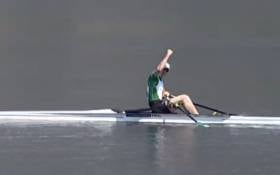Displaying items by tag: World Rowing Awards
Three Ireland Finalists for World Rowing Awards 2019
#Rowing: Ireland figure strongly in the finalists for the World Rowing Awards 2019. World champions Sanita Puspure, in the single sculls, and the lightweight double of Paul O’Donovan and Fintan McCarthy are finalists for women’s and men’s crews of the year. Ronan Byrne (21) is one of four finalists for the Filippi Spirit Award for outstanding university rower. Byrne won gold in the single sculls at the European Under-23 Championships just a week after partnering Philip Doyle to silver in the double sculls at the senior World Championships.
The award ceremony is on November 22nd in London.
Finalists for the 2019 World Rowing Awards
Thomas Keller Medal – for a rower who has had a long and successful rowing career and who has made an outstanding contribution to rowing as a competitor and as a sports personality.
- · Kim Brennan,Australia
- · Ekaterina Karsten,Belarus
- · James Cracknell,Great Britain
- · Pete Reed,Great Britain
- · Andrew Triggs Hodge,Great Britain
Filippi Spirit Award – for a university rower who has demonstrated the core values of rowing in his/her social, academic and sporting life and, through these values, also enabled or inspired exceptional success in other people's lives.
- · Ria Thompson,Australia
- · Jean Maillard,France
- · Ronan Byrne,Ireland
- · Nicholas Perovich,United States
World Rowing Sustainability Award – for an organisation that has implemented an innovative project or initiative delivering a clear and positive sustainability impact.
- · Spring Creek Regeneration Project,Australia
- · 2018 World Rowing Coastal Championships,Canada
- · Wintech: Clean air, water and solar power,China
- · Rowers Against Rubbish,Great Britain
- · Developing Environmental Ambassadors,Japan
World Rowing Para-rowing Crew of the Year
- · Kathryn Ross,Australia,Para PR2 Women’s Single Sculls
- · Ellen Buttrick, Giedre Rakauskaite, James Fox, Oliver Stanhope and Erin Wysocki-Jones (coxswain),Great Britain,Para PR3 Mixed Coxed Four
- · Lauren Rowles and Laurence Whiteley,Great Britain,Para PR2 Mixed Double Sculls
- · Birgit Skarstein,Norway,Para PR1 Women’s Single Sculls
- · Roman Polianskyi,Ukraine,Para PR1 Men’s Single Sculls
World Rowing Men’s Crew of the Year
- · Zhiyu Liu and Liang Zhang,China,Men’s Double Sculls
- · Valent Sinkovic and Martin Sinkovic,Croatia,Men’s Pair
- · Oliver Zeidler,Germany,Men’s Single Sculls
- · Paul O’Donovan and Fintan McCarthy,Ireland,Lightweight Men’s Double Sculls
- · Dirk Uittenbogaard, Abe Wiersma, Tone Wieten and Koen Metsmakers,The Netherlands,Men’s Quadruple Sculls
World Rowing Women’s Crew of the Year
- · Olympia Aldersey, Katrina Werry, Sarah Hawe and Lucy Stephan,Australia,Women’s Four
- · Yunxia Chen, Ling Zhang, Yang Lyu, Xiaotong Cui,China,Women’s Quadruple Sculls
- · Sanita Puspure,Ireland,Women’s Single Sculls
- · Zoe McBride and Jackie Kiddle,New Zealand,Lightweight Women’s Double Sculls
- · Grace Prendergast and Kerri Gowler,New Zealand,Women’s Pair
World Rowing Coach of the Year
- · Bernd Nennhaus,Germany,junior rowing crews
- · Tom Dyson,Great Britain,Para-rowing coach
- · Eelco Meenhorst,Netherlands,men’s sculling head coach
- · Gary Hay,New Zealand,women’s head coach
- · Johan Flodin,Norway,head coach
Ireland in Three Finals at World Rowing Awards
#Rowing: Sanita Puspure, the O’Donovan brothers and Ireland lightweight coach Dominic Casey have all been chosen as finalists for the World Rowing Awards 2018. Puspure won gold in the women’s single sculls and Paul and Gary O’Donovan won the lightweight double, coached by Casey, at the World Rowing Championships.
Just two crews, along with Puspure, are in the running for Women’s Crew of the Year, while there are four crews in the finals of Men’s Crew of the Year and for Coach of the Year. Casey has reached the final three years in-a-row.
The awards will be presented on November 23rd in Berlin.
Finalists for the 2018 World Rowing Awards
Women’s Crew of the Year
- Caileigh Filmer, Hillary Janssens, Canada, Women’s pair
- Sanita Puspure, Ireland, Women’s single sculls
- Agnieszka Kobus-Zawojska, Marta Wieliczko, Maria Springwald, Katarzyna Zillmann, Poland, Women’s quadruple sculls
Men’s Crew of the Year
- Joshua Hicks, Spencer Turrin, Jack Hargreaves, Alexander Hill, Australia, Men’s four
- Jason Osborne, Germany, Lightweight men’s single sculls
- Johannes Weissenfeld, Felix Wimberger, Maximilian Planer, Torben Johannesen, Jakob Schneider, Malte Jakschik, Richard Schmidt, Hannes Ocik, Martin Sauer (coxswain), Germany, Men’s eight
- Paul O’Donovan, Gary O’Donovan, Ireland, Lightweight men’s double sculls
Para-rowing Crew of the Year
- Perle Bouge, France, Para PR2 women’s single sculls
- Ellen Buttrick, Grace Clough, Oliver Stanhope, Daniel Brown, Erin Wysocki-Jones (coxswain), Great Britain, Para PR3 mixed coxed four
- Annika van der Meer, Corne de Koning, Netherlands, Para PR2 mixed double sculls
Coach of the Year
- Uwe Bender, Germany, Men’s eight
- Dominic Casey, Ireland, Men’s pair, lightweight men’s and women’s double sculls, lightweight men’s quadruple sculls
- Jan Klerks, Netherlands, Para-rowing team
- Laurel Korholz, United States, Women’s four, women’s single sculls
2018 Sustainability Award
- “Pushing for a Clean Sweep”, National Schools Regatta, Great Britain
- “Partnership with Waikato Water Authority”, Rowing NZ, New Zealand
- “Love Where you Row”, Alan Robinson/Schuylkill Navy, United States





























































